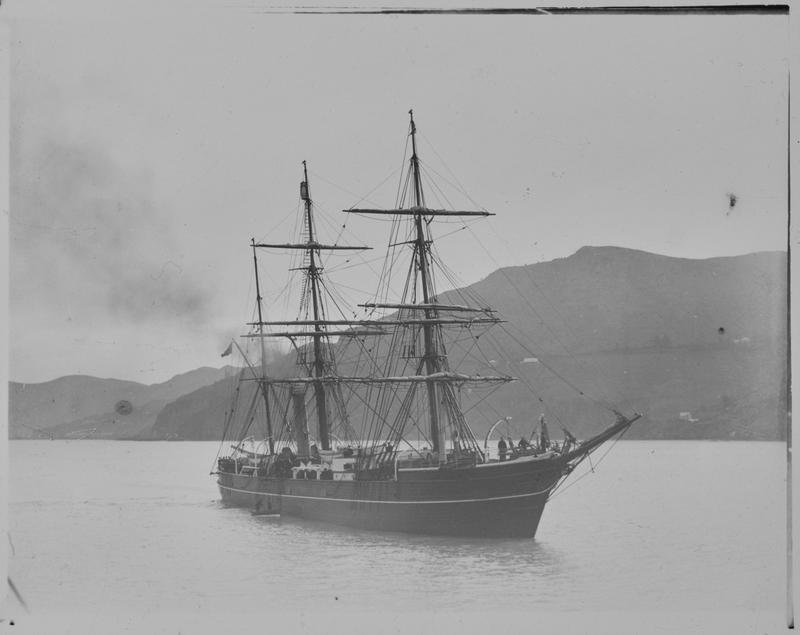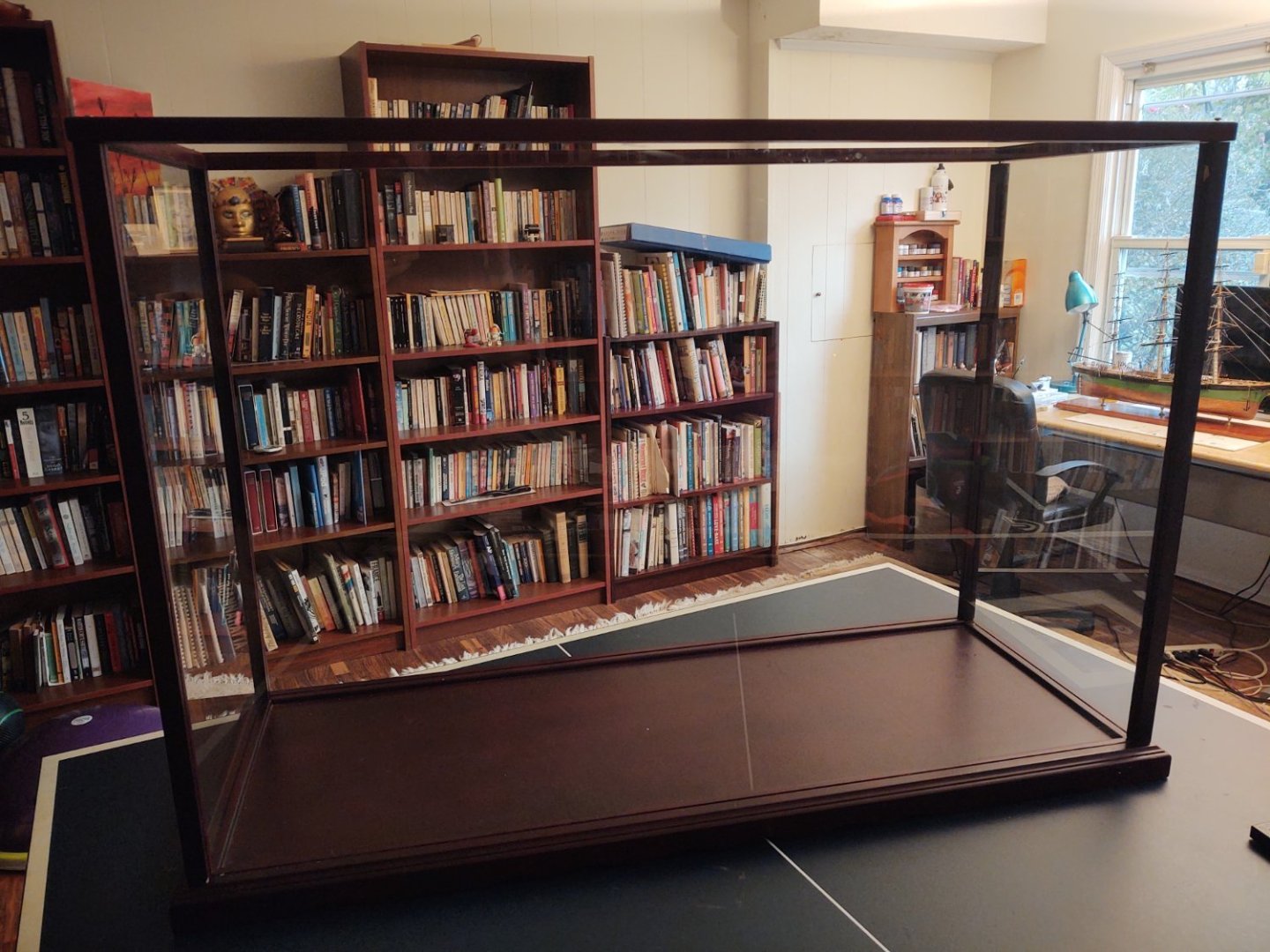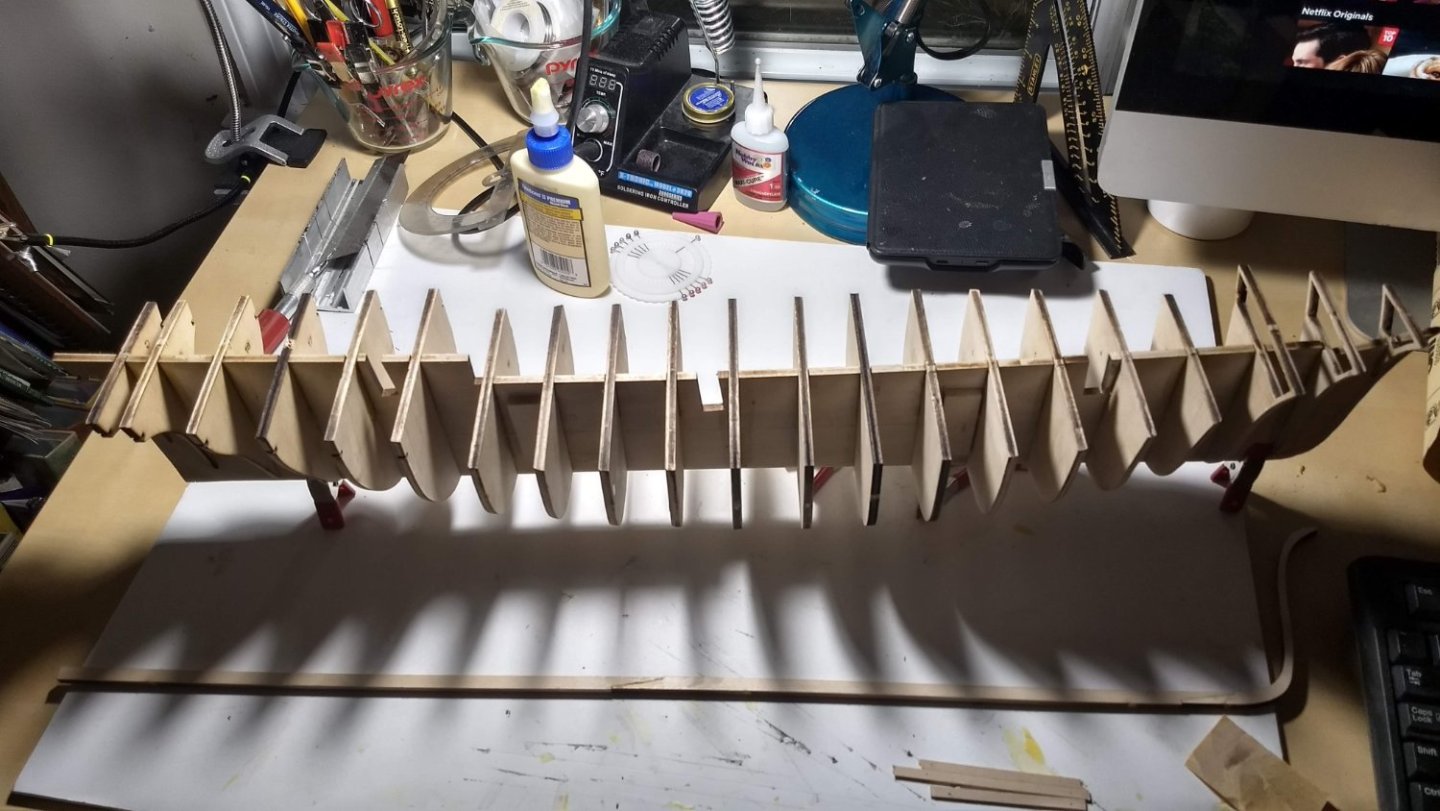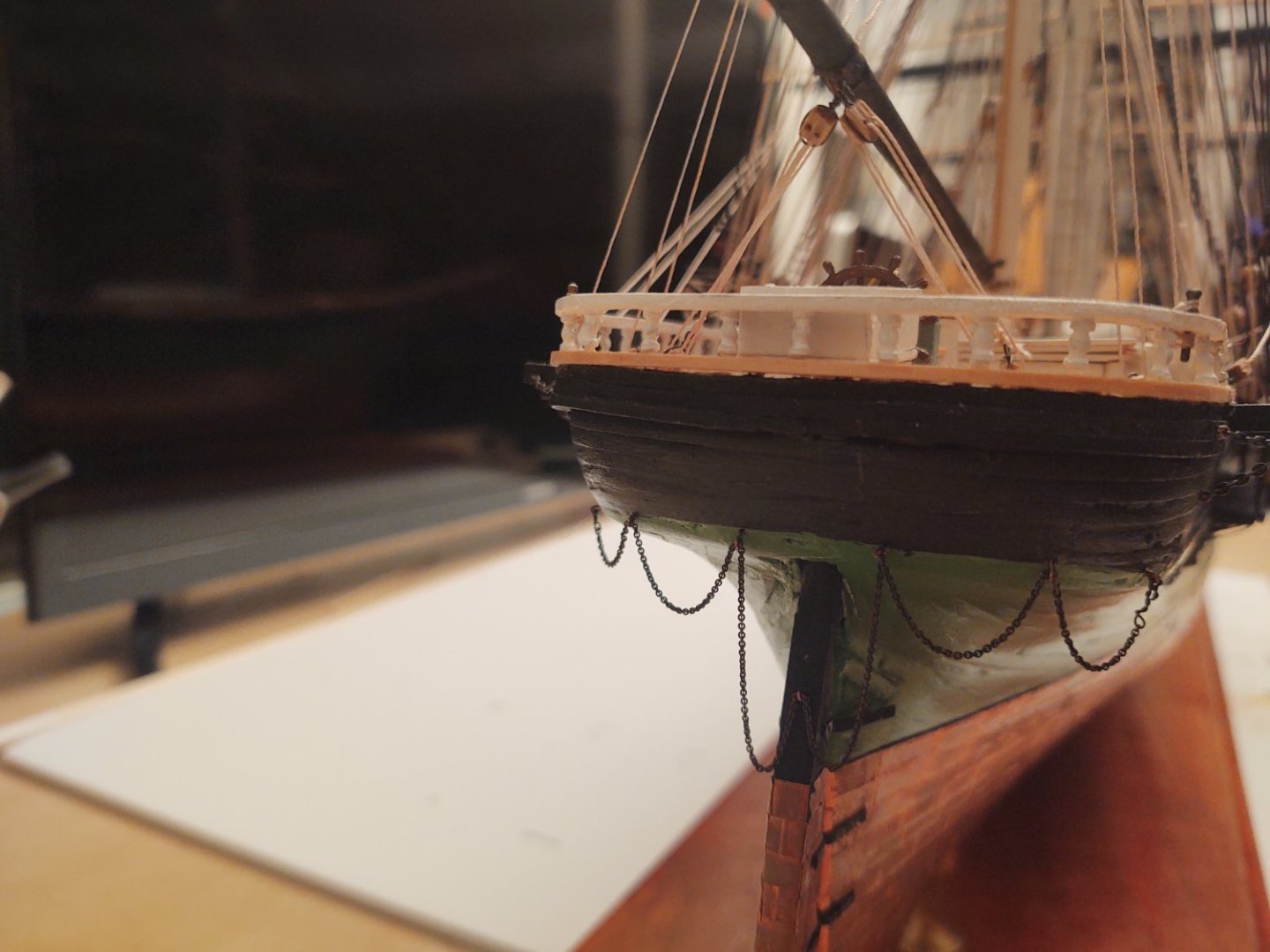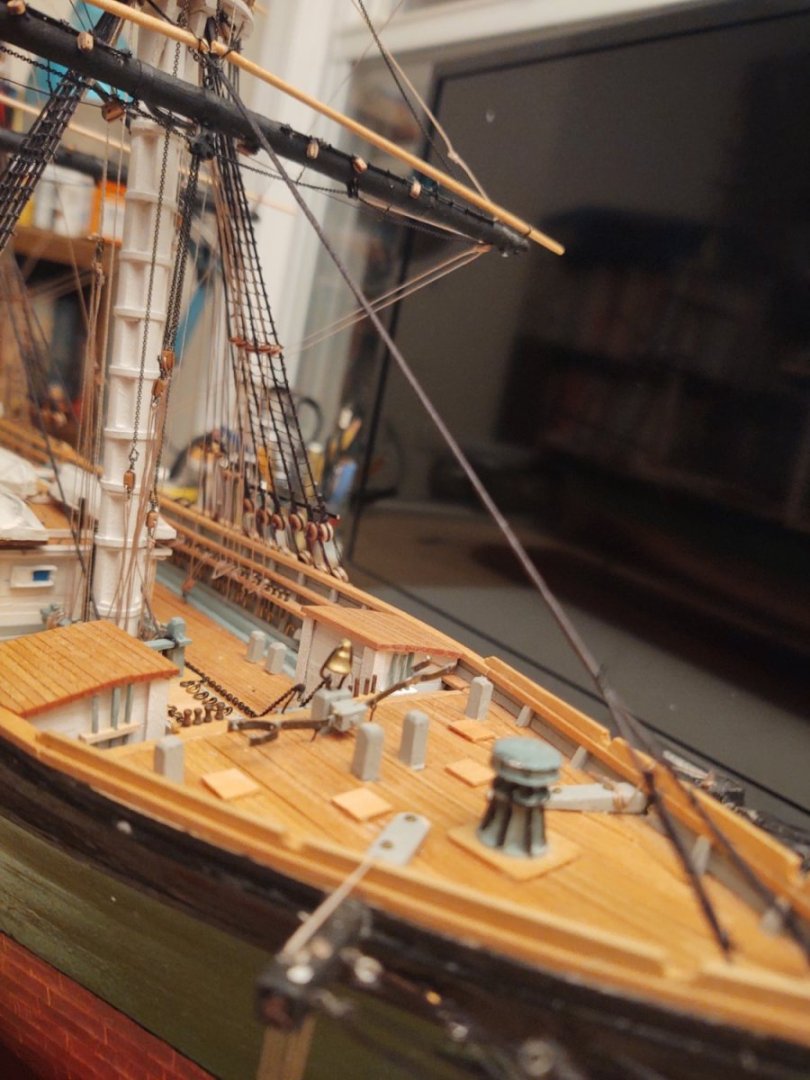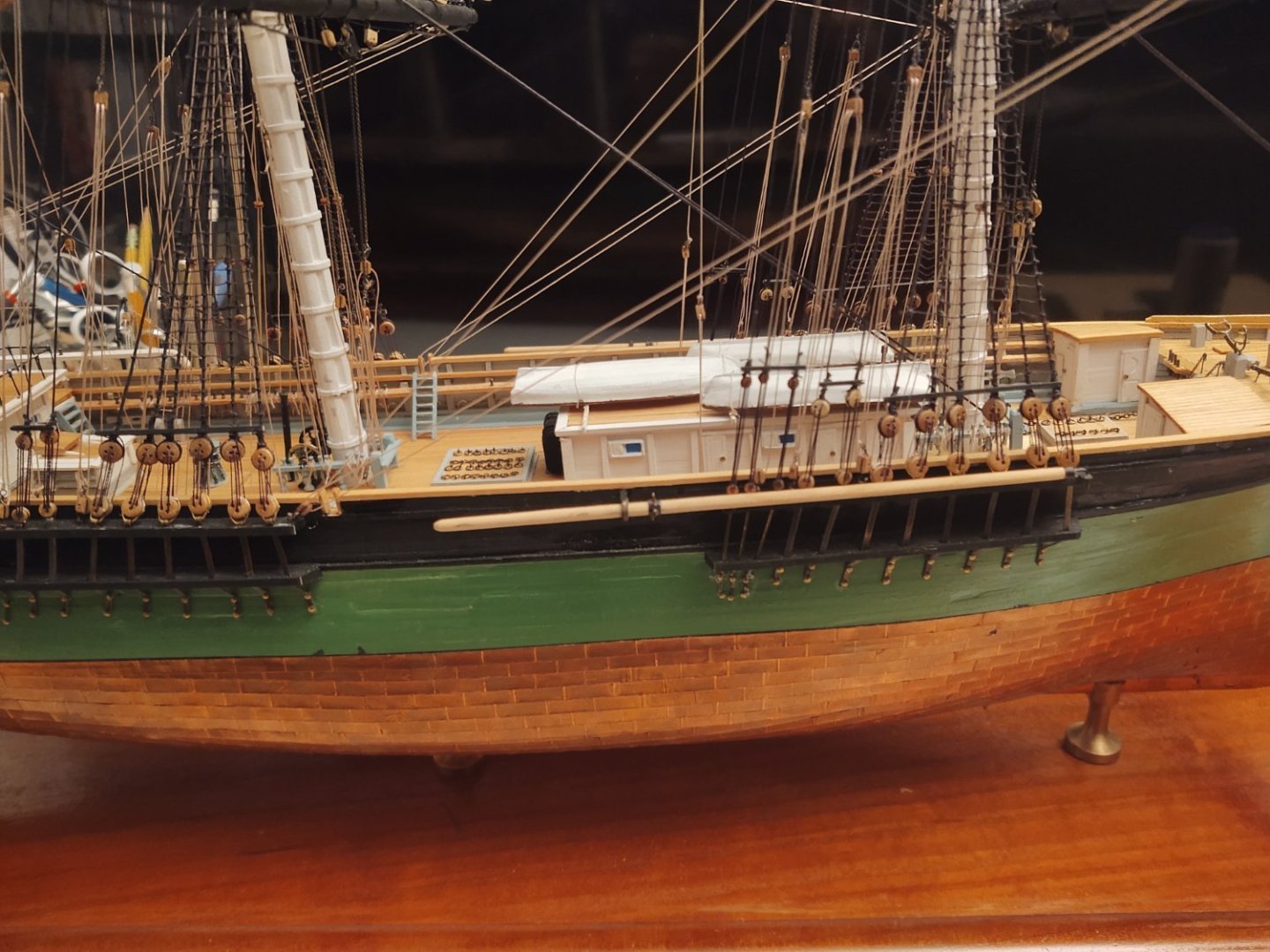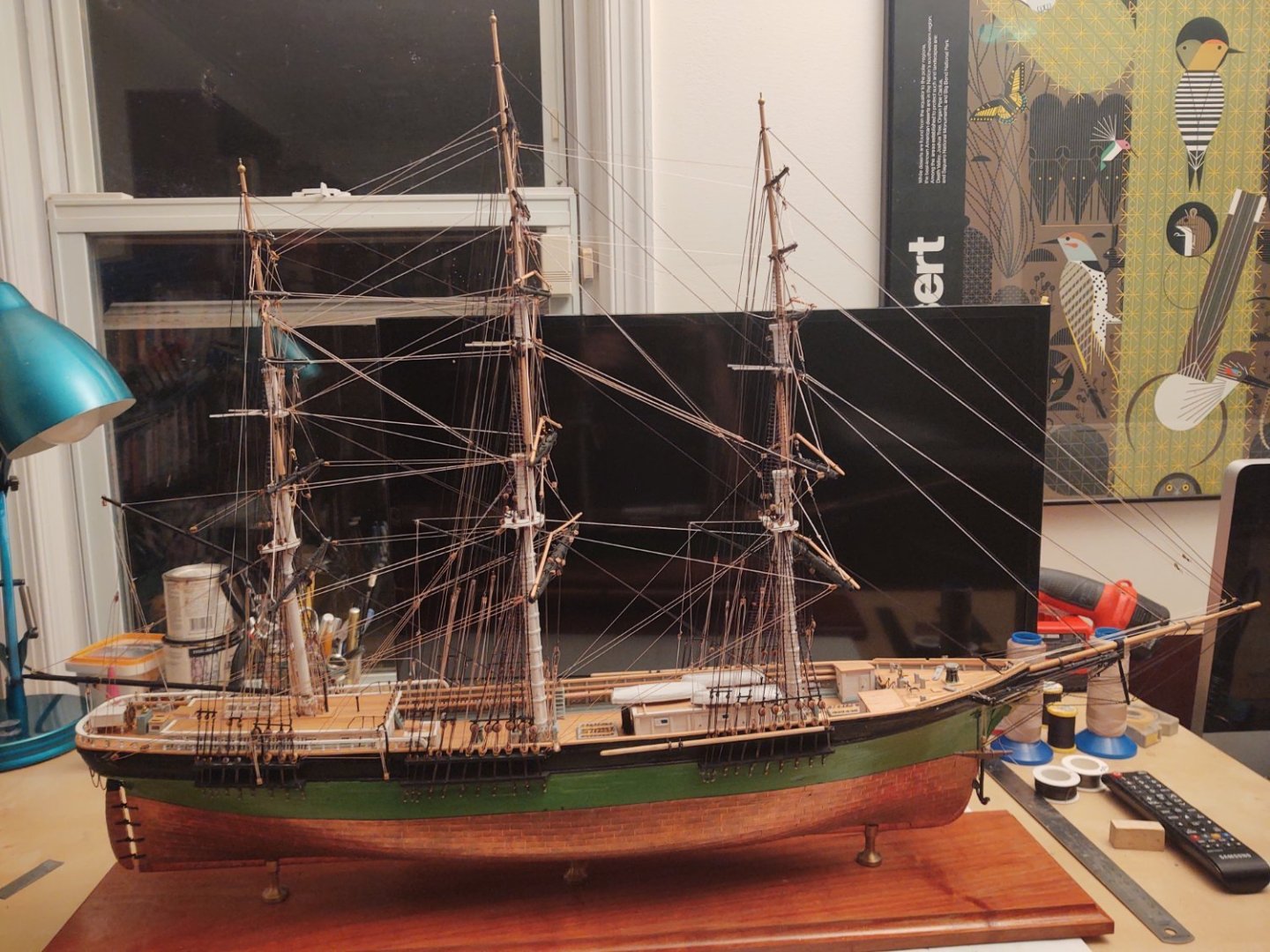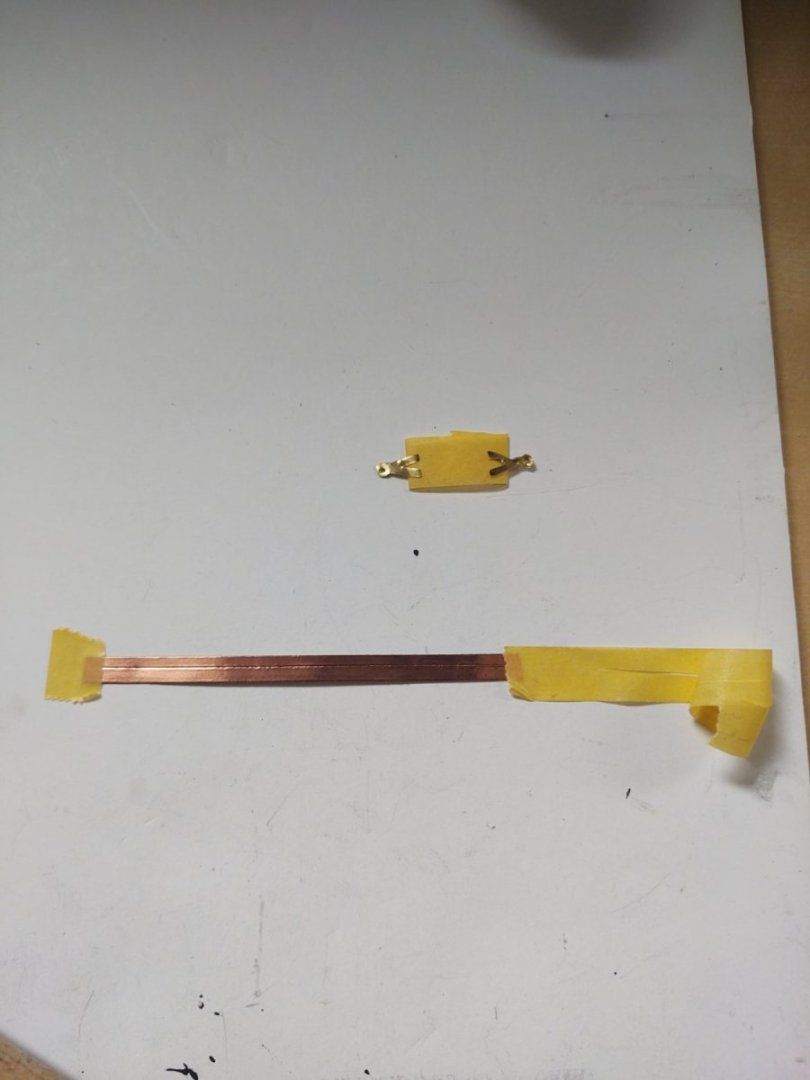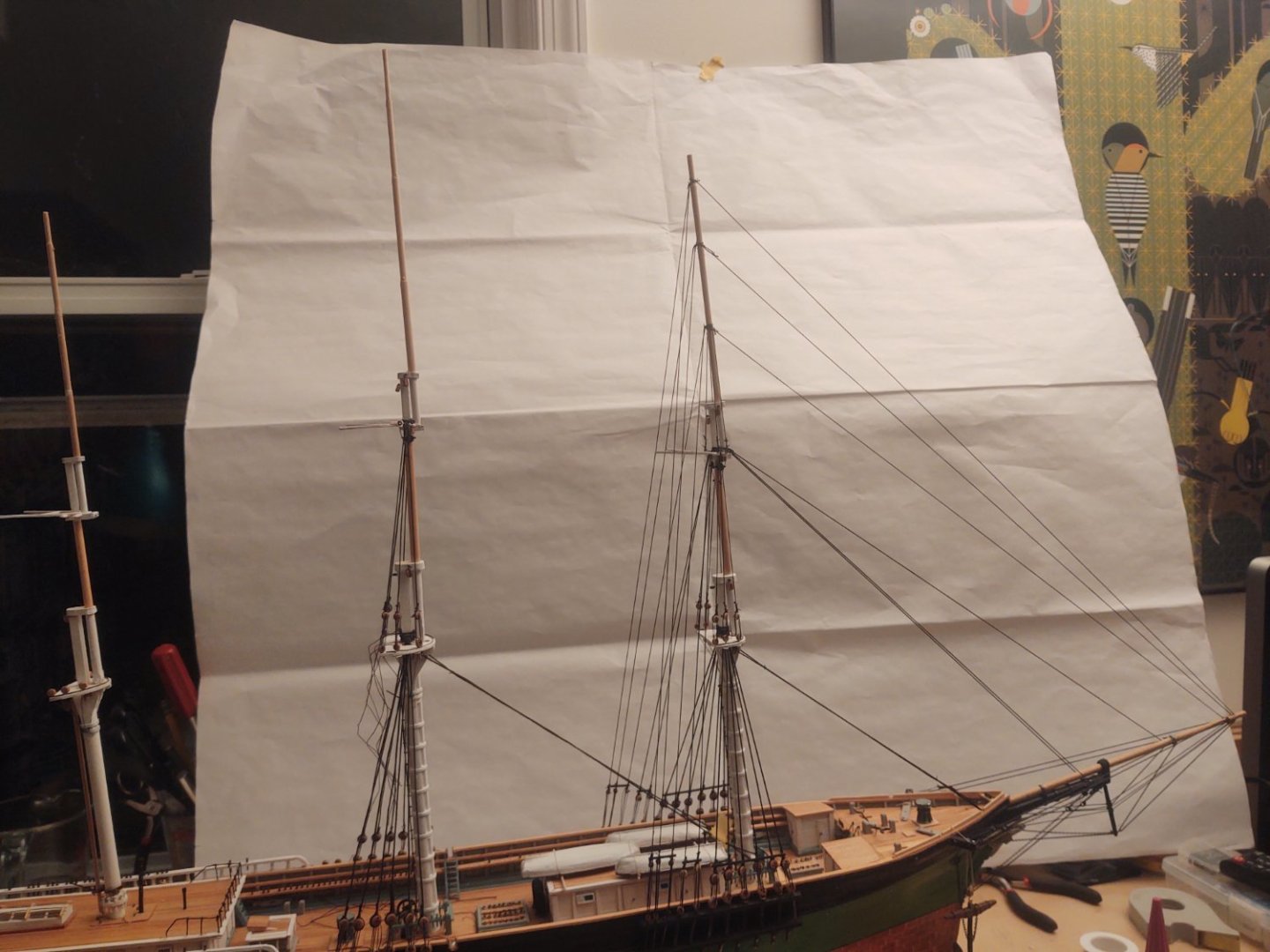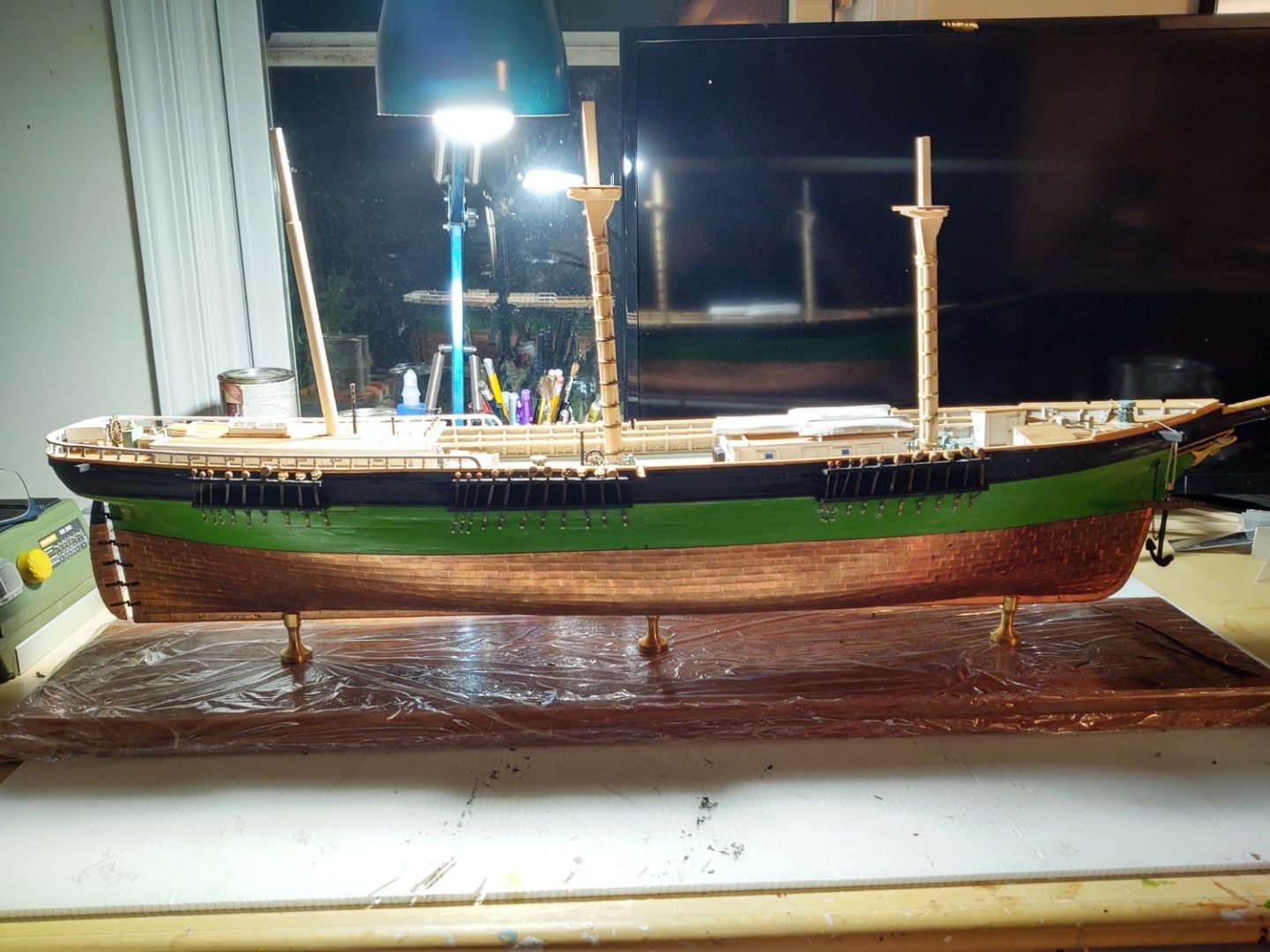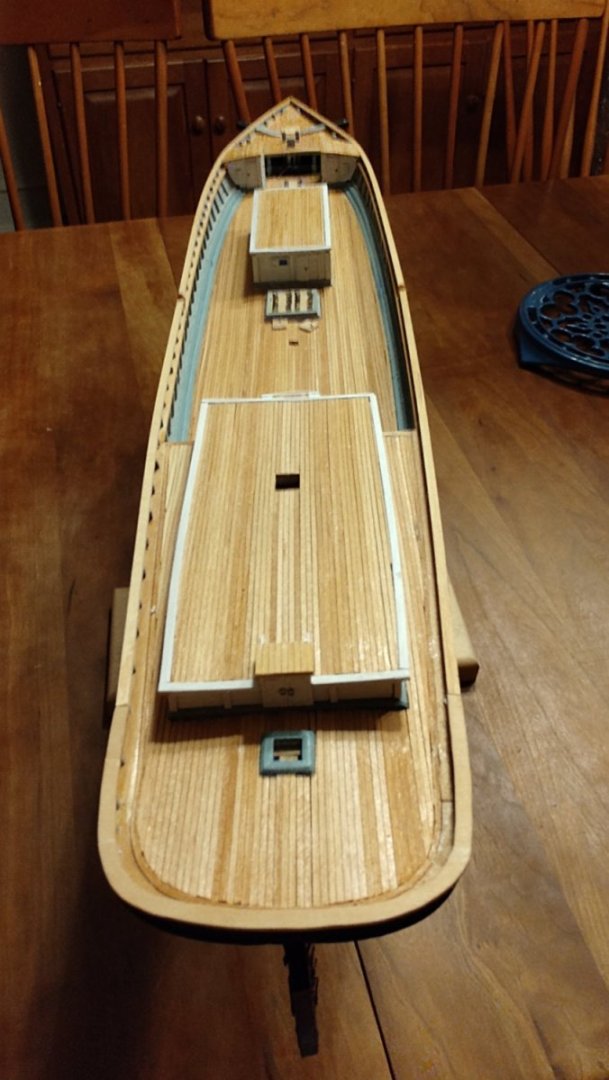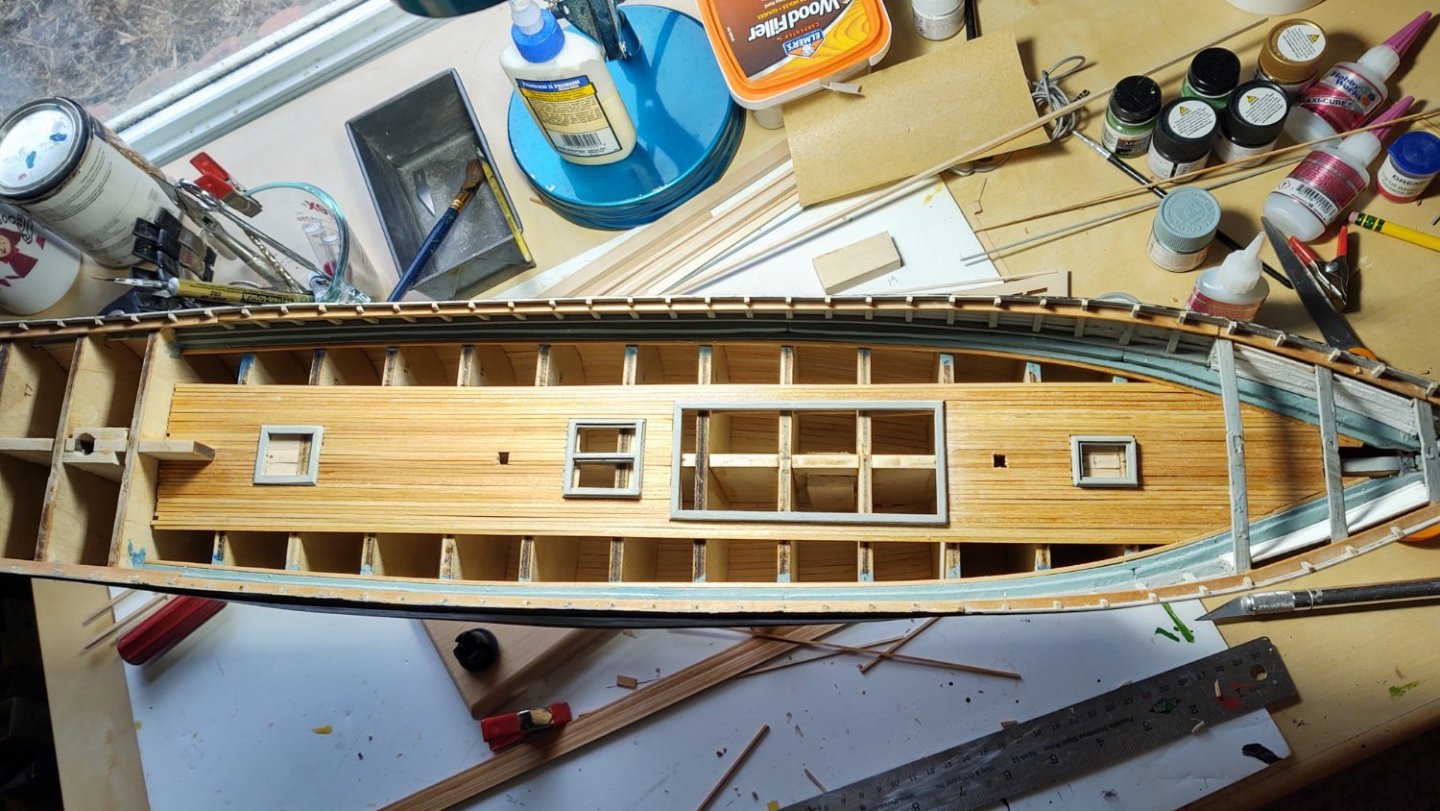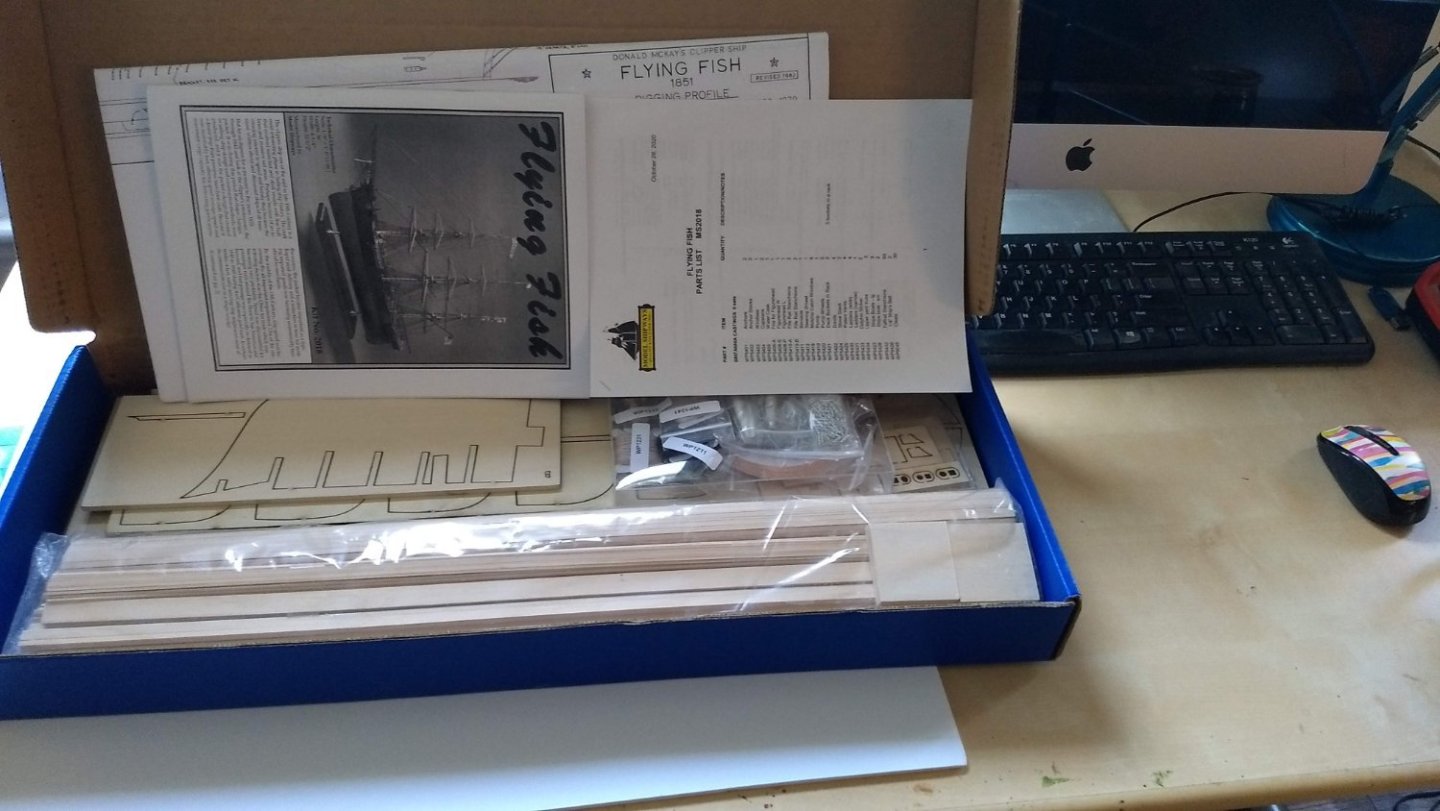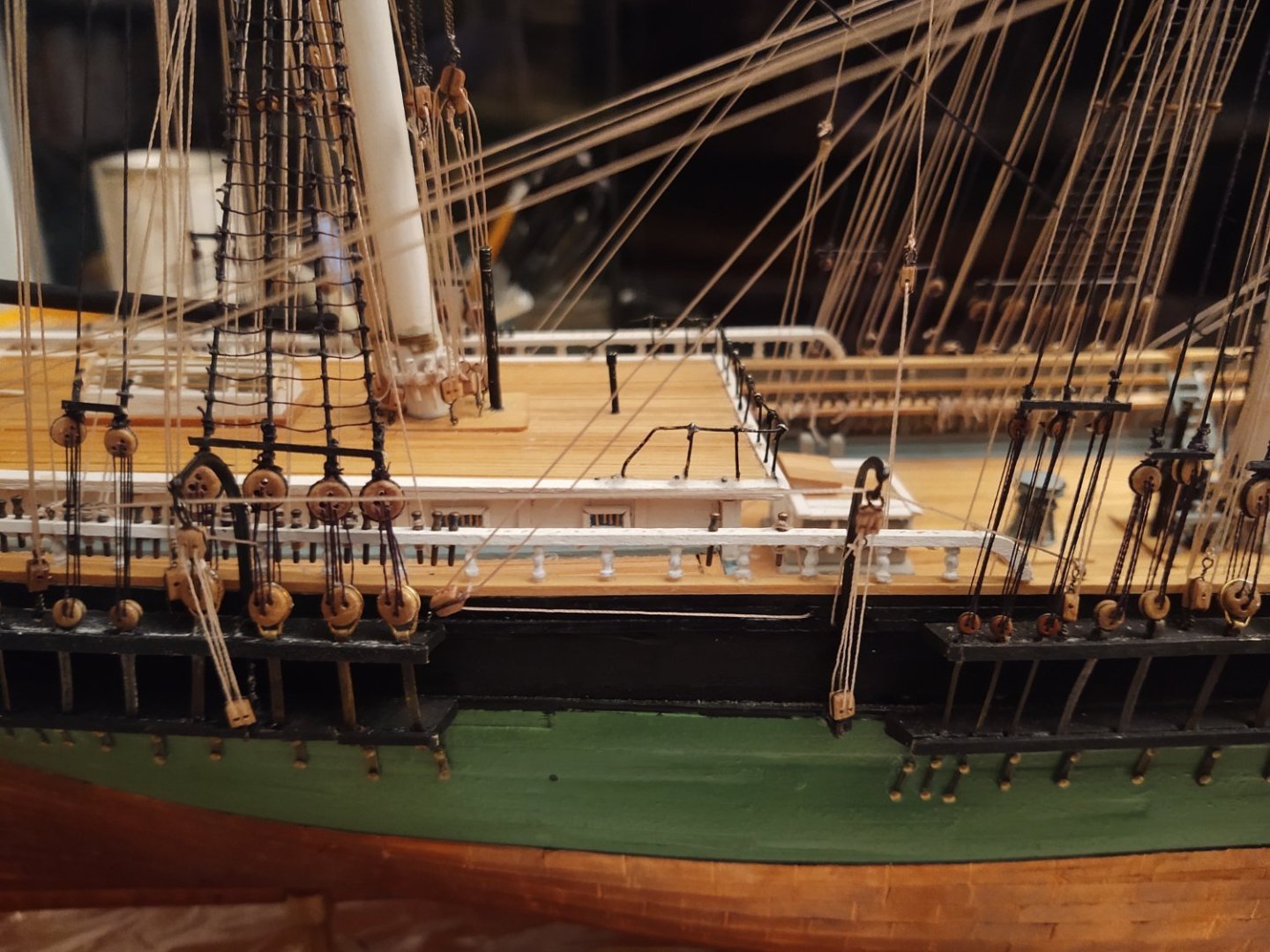-
Posts
717 -
Joined
-
Last visited
Content Type
Profiles
Forums
Gallery
Events
Everything posted by gak1965
-
Nice looking figurehead. It's got the grace of a real fish.
- 345 replies
-
- Flying Fish
- Model Shipways
-
(and 1 more)
Tagged with:
-
Bruce, The Discovery is in the Lloyd's Register starting in the 1901-1902 (R.F. Scott, RN listed as master). They appear to have plans for the replacement ship Discovery II from 1926, but no plans for the original. It does provide some details on the engine and it's manufacturer, which are quite interesting. A very interesting resource, thanks for the tip! George
-
I have plans for RRS Discovery from a number of sources. The Discovery Point Museum in Dundee (where the ship is docked) sent me a few, along with some photos, and I ordered some of the large collection of plans for the RRS Discovery that the National Maritime Museum (NMM) has in Greenwich. I ordered 6 from the NMM, primarily because I had to pay for the scanning charges, which run £70 for the first document and £50 for the following ones. The docs I ordered were: Lines Main/Lower Decks/Hold Hold/Sections Sections Mast and mountings Profile, Upper, Forecastle & Bridge Decks It turns out that I probably didn't need docs 2,3, or 4, but that was only known in hindsight. Just to give you bit of an overview of what the plans are like, and something about the ship (while keeping to my obligations under the NMM license) here are some details, but not the complete drawings (and at lower resolution). So, looking at part of the sheer plan you will see that the ship has a bit of a drag: I will need to plot some more stations to make the hull flow better, but that shouldn't be a problem. If you wanted to do a full plank on frame, the section sheets have really great construction details, although the content of 3 and 4 are quite similar. The ship has three layers of wood in much of the hull, an inner layer on the inside of the frames, and up to two additional layers on the outside of the frame. Here is an example section through the engine room. The ship has a 450 hp triple expansion steam engine mounted vertically. You can see the three layers of wood in this as well. Again from the sheer diagram. The hardest thing to build on the hull is likely to be where the prop was located. If you look at the bottom of the image, you will see an octagonal structure - this was so that the prop could be raised into the ship for easy repair. My original thought was to cut the center keel for the POB ship to include the mount for the rudder, but I'm less sure now. I may add the rudder mount after I've cut the octagon in the planked ship, or maybe I will add the octagon prior to planking. Not sure at the moment, still thinking that through. The detail of the weather deck plans is excellent. Here is an excerpt over the engine rooms. A number of interesting features here, including the coaling scuttles. You can see (on the right hand side) 4 of the myriad mushroom vents that were used to provide light and ventilation to the lower decks. They were used because of the concern that portholes would compromise the structural integrity of the ship. Here is a photo of them (Link: https://commons.wikimedia.org/wiki/File:Deck_(336716710).jpg) The ship's rig was designed to support an expedition far from home. This shows the fore and main mast, but if you look, although they look different, they were intentionally designed to use the same size masts and yards (i.e. the main and fore course yards were the same, etc.) so that they could carry fewer types of spares in a location where there were no trees to build new ones. The difference in heights is driven by where they are stepped, not because they are different sizes. This was an antarctic vessel, so it has plates on the bow to help break the ice (this is a closeup of a plan that Discovery Point kindly sent me). And they sent a rigging plan (which I am going to ask them to take a closer photo of). The sheet with the masts has most of the standing rigging, and the data on the routing of the lifts, sheets, clews, and buntlines, but not the braces, which are shown here. More important is the size and type of lines in the upper left corner, which will be very helpful when it comes time to build yards and rig. The key thing is that the lines are a mix of steel and hemp. I have yet to find something that is an obvious belaying plan, nor are there any pinrails shown on the plans, although they are visible on photos. I will ping Discovery cove and look at some of the photos at the Scott Polar Research Institute to make up my mind, but I suspect like a lot of contemporary ships they just had pinrails throughout the ship. Link: https://commons.wikimedia.org/wiki/File:RRS_Discovery_Dundee_Main_mast_rigging.JPG A couple of other observations from this photo. Note that the ratlines are slats, so, no knots. Not so yea, as I need to figure out how they are mounted. Again, email to Discovery Point. ALso, note that it looks like they use bar fairleads rather than trucks, which I find much easier. So, that is where we currently stand. Next step is to get a full sized (i.e. at 1:64) printed someplace with a big printer, and then figure out where the boundaries on the centerpiece and the keel. Take the lines and cut out patterns for the bulkheads on paper, and then eventually get to the point where I can buy some wood and think about cutting it out. Regards, George
-
Hello. This is the start of what will become a build log for a scratch version of the RRS Discovery, a Royal Research Ship built in 1901 to support what was officially called the British National Antarctic Expedition, but which eventually became known as the Discovery Expedition of 1901-1904 after the ship. I'll go into more information about the expedition later, but suffice it for now to say that it was led by Commander Robert Falcon Scott and included such other polar explorers as Ernest Shackleton (of Endurance fame) and Reginald Skelton, who was her Chief Engineer. Although on an official government expedition, and her officers were on loan from the Royal Navy, the ship itself was not a RN vessel, as such, she used the Blue Ensign rather than the Red Ensign. One might ask why build the Discovery. Well, for a start, I think that Discovery has been more than a bit overshadowed by the Endurance, and rather unfairly at that. To date, I am only aware of an uncommon Airfix kit of her. Unlike Endurance, she came home, was used for exploration in other areas, and still remains to this day, in Dundee, where she was built. I find her an interesting subject because she is a transitional ship, a steam vessel but with a full Barque rig, and was fitted out as a floating research lab, designed to conduct science in a hostile environment far away from any help; the epitome of exploration. The ship is the namesake of many other vessels doing difficult things in difficult places, including several other Royal Research Ships: Discovery II (1929), Discovery (1962) and Discovery (2013). Space Shuttle orbiter OV-103 Discovery is named after her, and several other ships with similar names, and the ship Discovery-1 from 2001: A Space Odyssey was also named after her, as Arthur C. Clarke used to eat his lunch on her while she was in London. As I indicated, the ship is still in existence in Dundee. This is a wonderful, but imperfect reference, as she has been modified a number of times. Her rig is rather different now (5 vs 4 yards on the square rigged masts, for example, and my goal is to make her as she appeared in 1901 on her way to Antarctica for the first time. I should also point out that this log is starting with the development of a Plank-on-Bulkhead design that I can implement. My suspicion is that I won't really be making sawdust until some time in the new year. With all that out of the way, let's have a look at the ship (photo source link here: https://commons.wikimedia.org/wiki/Category:Discovery_(ship,_1901)#/media/File:Stern_of_the_Discovery_-_geograph.org.uk_-_1805082.jpg) As you can see, she is a Barque rigged steamship. The hull is relatively straight sided above the planksheer, and we have three masts, two square rigged, with a fore and aft mizzen. To give some scale her dimensions are: Length between perpendiculars: 172 feet Beam (extreme): 33 feet I expect that when the spanker boom, bowsprit and jibboom are accounted for, she'll be 200-210 feet long, or about 39 inches with a hull 6 inches wide. Here are a few photos of the ship during the expedition. For those that aren't aware, the ship spent several years bound in ice, so many of the photos show her in that condition. (Source link: https://commons.wikimedia.org/wiki/Category:Discovery_(ship,_1901)#/media/File:The_ship_Discovery,_Antarctica,_1901.jpg) Source link: https://commons.wikimedia.org/wiki/Category:Discovery_(ship,_1901)#/media/File:The_ship_Discovery,_Antarctica,_1901.jpg Discovery by the ice. Link: https://commons.wikimedia.org/wiki/File:Discovery_alongside_Barrier.jpg The ship's officers including Scott (center, 3 stripes on sleeve). Source link: https://commons.wikimedia.org/wiki/File:ATLNZ_11715.jpeg And here are is a photo from the New Zealand Maritime Museum Hui Te Ananui a Tanaroa. (New Zealand Maritime Museum Hui Te Ananui a Tangaroa, [https://collection.maritimemuseum.co.nz/objects/51662/lantern-slide-rrs-discovery-1901-barque-rigged-auxiliary-steamship (accessed on 2023-11-21], ) Hopefully, this will whet your appetite for the ship. On my next post I'll describe the plans that I have been able to obtain so far. Regards, George
-
Starting to go off topic here, but that person also appears to have a video of @mbp521 (aka Brian's) USS Cairo model, and I'm guessing others (I haven't dug into it - life's too short, but the Cairo popped up in the 'you might like' after the video).
- 602 replies
-
- Flying Fish
- Model Shipways
-
(and 2 more)
Tagged with:
-
Well, answering the second question first, I can only speak for myself when I say I wish I had some of his old models to remember him by. The only one that survived the years and the moves was a 3" tower with a checkered flag that was part of an old HO scale Aurora slot car set from the mid '60s. It's part of a very small set of physical things I have to remember him by (the rest are some photos and the light from the top of his taxicab). As to the first question, I'm not a materials scientist, but my read is that most plastics are going to take the bulk of their damage from UV via creation of free radicals, and how deep it goes will be driven by a number of factors associated with the mobility of the radicals in the specific material. I would presume any paint would provide an ablative surface that would protect the underlying plastic against UV derived free radicals, and might (depending on properties) be more or less resistant to UV and/or more or less likely to spread the radicals than the underlying plastic itself. Wishy-washy I know, but hard to see how paint wouldn't at least help a little and probably help a lot. My $0.02. Regards, George
- 602 replies
-
- Flying Fish
- Model Shipways
-
(and 2 more)
Tagged with:
-
Thanks Vlad and John! John, I think most of the pictures in that video are of @MikeR's scratch Flying Fish, but there does appear to be one at the end of the fish before I had crossed the yards. Regards, George
- 602 replies
-
- Flying Fish
- Model Shipways
-
(and 2 more)
Tagged with:
-
I haven't had a chance to take good photos yet. It's been a busy work week, and I was hoping to take some nice ones today (it's a holiday for my company), but it's dim and rainy. I did get the case ready. This was a case my dad bought for the Revell Constitution, so another 1:96 ship, but for some reason he ordered one 36 inches tall. I have it now, because when they moved to an apartment, he kept the ship but not the case. Anyways, I cut 7 inches off the bars and took the glass to the local hardware store and got it cut down to 29 inches. He didn't use anything to hold the glass in, the bars have screws to hold them in place, but when I reassembled it, I used some silicone to attach the rear and side glass panes to the bars. I don't intend to do so to the front panel, I will slide it in place after the model is placed. The front panel (which is in the back in this picture) isn't in place yet, among other reasons, because it broke as I was taking it out of the car at the hardware store (sigh). That said, 4 of the 5 panels survived 18 months in my garage, and the recutting, which is probably close to miraculous. I may get a piece of plexiglass for the front panel (although, paradoxically it appears to cost more than glass). Then we need to figure out where it is going. Our ping pong table is not a good long term location. Regards, George
- 602 replies
-
- Flying Fish
- Model Shipways
-
(and 2 more)
Tagged with:
-
Thanks Scott! FWIW, as I mentioned earlier in this log, I have a weak spot for old Revell sailing ships because my grandfather built the Cutty Sark and was working on the Constitution when he died. A restoration of one of his ships (which were, alas destroyed and/or lost over the intervening 55 years) would be great; I wish you the best in completing the restoration of the Thermopylae your mom built. Regards, George
- 602 replies
-
- Flying Fish
- Model Shipways
-
(and 2 more)
Tagged with:
-
Thanks Rob! I followed your log on Glory and used many of your techniques, which was a great help. Regards, George
- 602 replies
-
- Flying Fish
- Model Shipways
-
(and 2 more)
Tagged with:
-
Thanks! I'm watching your Gorch Fock restoration. I wish you the best on that project. Regards, George
- 602 replies
-
- Flying Fish
- Model Shipways
-
(and 2 more)
Tagged with:
-
Thanks Eric! I like the time lapse too - when (if) I finish another I think I'm going to use it again as well. Regards, George
- 602 replies
-
- Flying Fish
- Model Shipways
-
(and 2 more)
Tagged with:
-
Thanks Rob, I am following your build of Stefano. You are way braver than I doing those sails! Regards, George
- 602 replies
-
- Flying Fish
- Model Shipways
-
(and 2 more)
Tagged with:
-
Thanks Jared, I continue to watch your build with interest. Took me a week to decide, but I'm going to do two that are likely going to move at very different velocities: BlueJacket USS Kearsarge RRS Discovery Since the former is a kit and the latter is scratch, I imagine I won't really be making sawdust on it for a while. I have the builders plans from the NMM in Greenwich and some items from Discovery point in Dundee and need to convert it into bulkheads that can be modeled. Regards, George
- 602 replies
-
- Flying Fish
- Model Shipways
-
(and 2 more)
Tagged with:
-
Thanks Chris! Appreciate the vote of confidence!
- 602 replies
-
- Flying Fish
- Model Shipways
-
(and 2 more)
Tagged with:
-
Thanks Steve. I appreciate the sentiment!
- 602 replies
-
- Flying Fish
- Model Shipways
-
(and 2 more)
Tagged with:
-
Thanks Rick! I am following your Fish build as well, and looking forward to seeing it finished!
- 602 replies
-
- Flying Fish
- Model Shipways
-
(and 2 more)
Tagged with:
-

Rigging the Endurance by Occre
gak1965 replied to David Enghauser's topic in Masting, rigging and sails
It's hard to say without a picture but those could be fairleads for other lines. They are definitely not for the 5 lines you mention (which I interpret to be the shrouds which go through the large "lubber's hole). If they are fairleads, they are there to provide clear paths for some of the running rigging, typically things like braces, sheets, and clews from the top and topgallants that need to get through below the top (the platform). You may have other fairleads mounted in the forecastle, or the shrouds themselves (either a strip of wood with holes or a set of "trucks", wooden disks with holes drilled in them) attached midway up the shroud. It's all there to keep the rigging from getting tangled. Regards, George -
Well, I still need to buy some transfer letters to make the name, but I've removed the Saran wrap covering the base and I'm calling this one FINISHED. 2 years, 355 days after starting. I don't have a lot of great photos (I'll take them during the day and in a better setting), but I've got a couple of the now completed ship. First, couple of snaps of the last steps. The preventers on the rudder: The forward bell: The lower, fore stuns'l boom mounts (I lost one of the ones shown and had to remake it), and the mounts+booms in place. The mount was made from sheet brass, the boom iron from copper venture tape painted black, and boom rest from 1/16 by 1/32 brass, with the lower support made from annealed steel wire. Finally, please take a journey with me, having a look at the ship at approximately 6 month intervals. NOVEMBER 2020: MAY 2021 (6 months) NOVEMBER 2021 (1 year) MAY 2022 (1.5 years) NOVEMBER 2022: (2 years) MAY 2023: (2.5 years) And finally, completed, November 4, 2023: (3 years) Thank you all for your suggestions, assistance, and for following along so that I didn't give up somewhere along the way. As I said, I'll post more, better pictures in a couple of days. Now I need to figure out what is going to be next. Regards, George
- 602 replies
-
- Flying Fish
- Model Shipways
-
(and 2 more)
Tagged with:
-
No new photos today. But, completed: Portside davits, guy, and boat tackle Gilded balls on mast trucks: I used a couple of about 3 mm beads from my wife's stash, used a belaying pin to represent the top coming from ball, painted them gold and installed them. Preventer chains on the rudder. Somehow I missed them before. That leaves: Stuns'l booms on hull: 2 Forward bell: 1 Decals: 3 I'm starting to wonder if I dreamed the decals. There is a flag sheet in the parts list, but no decals. I will try to find some good transfer letters to make the name. My guess is that there are train ones that will work. If that's the case, all that's left are the booms and the bell. I'll go over the ship and see if I'm missing anything, but with any luck, I'll be done this weekend. Regards, George
- 602 replies
-
- Flying Fish
- Model Shipways
-
(and 2 more)
Tagged with:
-
Honestly the casks look great as is. Don't know that I would bother doing anything to them Regards, George
- 345 replies
-
- Flying Fish
- Model Shipways
-
(and 1 more)
Tagged with:
-
Okay, well, I have mounted the starboard side davits. Here is a photo: The photo isn't great, but here are the basics. Fore davit on a small platform I built at the planksheer. Aft between shrouds 3 and 4. I put the guy in, but simplified the rigging. The plans show a bolt at the after end, and a tackle, belayed to a pin on the main rail forwardl. I just ran it to a eyebolt on the main rail. I looked at rigging the boat tackles in an X pattern but didn't like the look, so they are rigged vertically, with the hooks attached to the lower channel or the platform directly beneath the davit. It doesn't look vertical (it's an artifact of the photo), but it is. The list: Stuns'l booms on hull: 2 Davits: 4 2 Boat tackle: 4 2 Guy wires on davits 2 1 Gilded balls on mast trucks: 3 Decals: 3 Total = 13 Regards, George
- 602 replies
-
- Flying Fish
- Model Shipways
-
(and 2 more)
Tagged with:
-
Yeah, there are two things constraining the location of the forward davit - need to be aft of the freeing port and forward of the sheave for the main course brace. As depicted on both paintings, they seem different than the davits on something like the Cutty Sark, in that the guys would seem to limit their ability to rotate. In that case they would only be able to easily launch and recover the specific boats in the davit, more like modern lifeboat davits. How the heck they launched the boats stored on the cabin is a mystery to me. You'd need to manhandle them over to the davits first at a minimum, and if they can't rotate, getting the boat in place must have been challenging, but I could well be missing something. Regards. George
- 602 replies
-
- Flying Fish
- Model Shipways
-
(and 2 more)
Tagged with:
About us
Modelshipworld - Advancing Ship Modeling through Research
SSL Secured
Your security is important for us so this Website is SSL-Secured
NRG Mailing Address
Nautical Research Guild
237 South Lincoln Street
Westmont IL, 60559-1917
Model Ship World ® and the MSW logo are Registered Trademarks, and belong to the Nautical Research Guild (United States Patent and Trademark Office: No. 6,929,264 & No. 6,929,274, registered Dec. 20, 2022)
Helpful Links
About the NRG
If you enjoy building ship models that are historically accurate as well as beautiful, then The Nautical Research Guild (NRG) is just right for you.
The Guild is a non-profit educational organization whose mission is to “Advance Ship Modeling Through Research”. We provide support to our members in their efforts to raise the quality of their model ships.
The Nautical Research Guild has published our world-renowned quarterly magazine, The Nautical Research Journal, since 1955. The pages of the Journal are full of articles by accomplished ship modelers who show you how they create those exquisite details on their models, and by maritime historians who show you the correct details to build. The Journal is available in both print and digital editions. Go to the NRG web site (www.thenrg.org) to download a complimentary digital copy of the Journal. The NRG also publishes plan sets, books and compilations of back issues of the Journal and the former Ships in Scale and Model Ship Builder magazines.



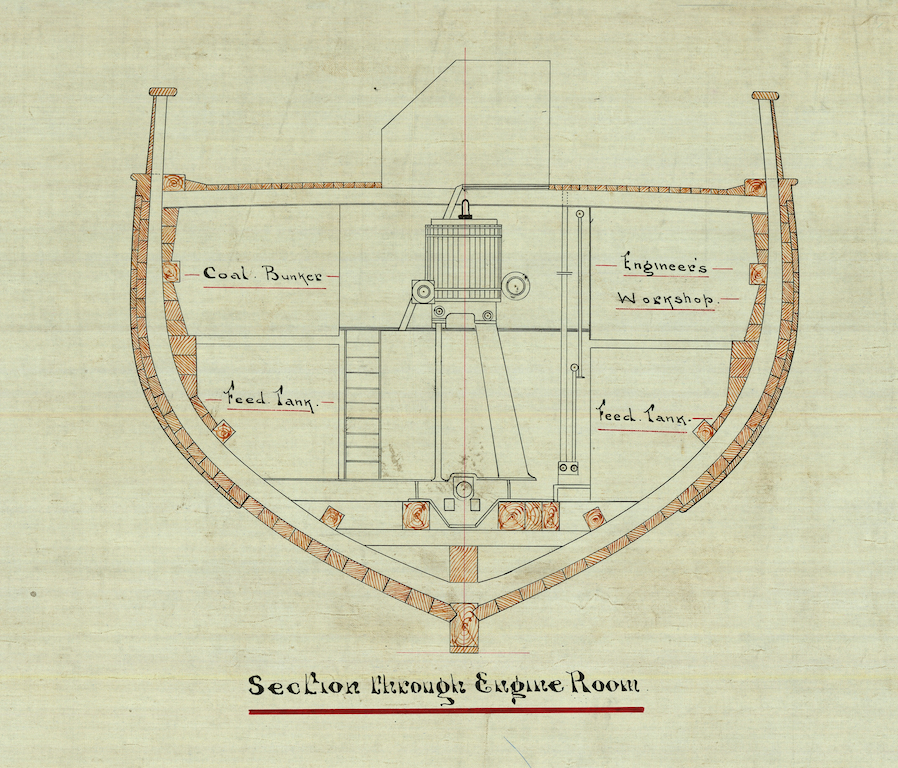
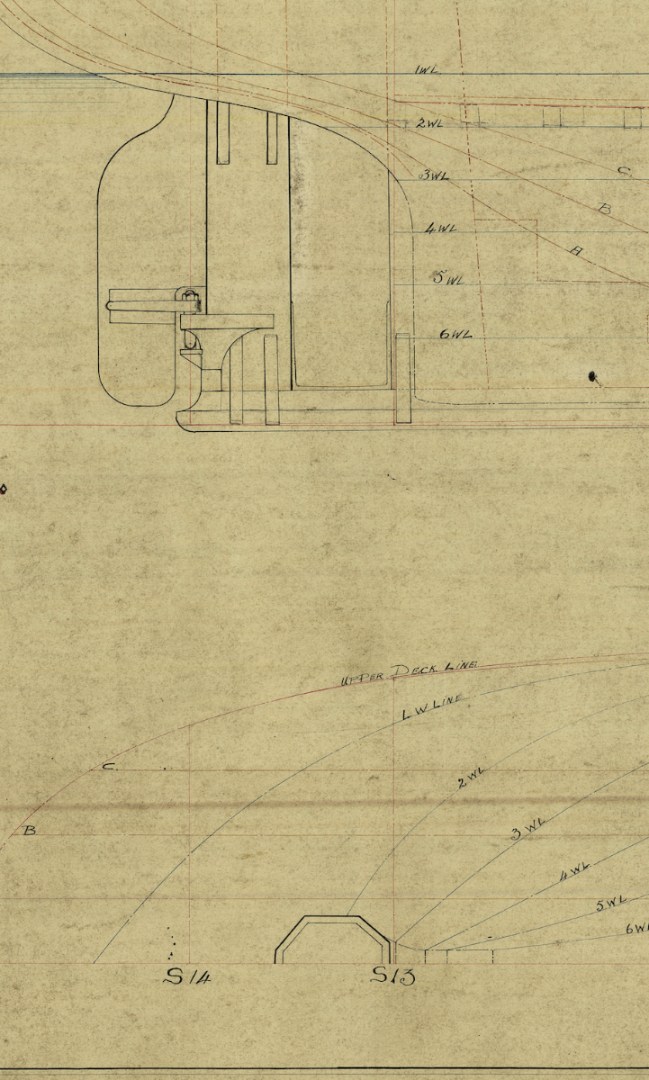
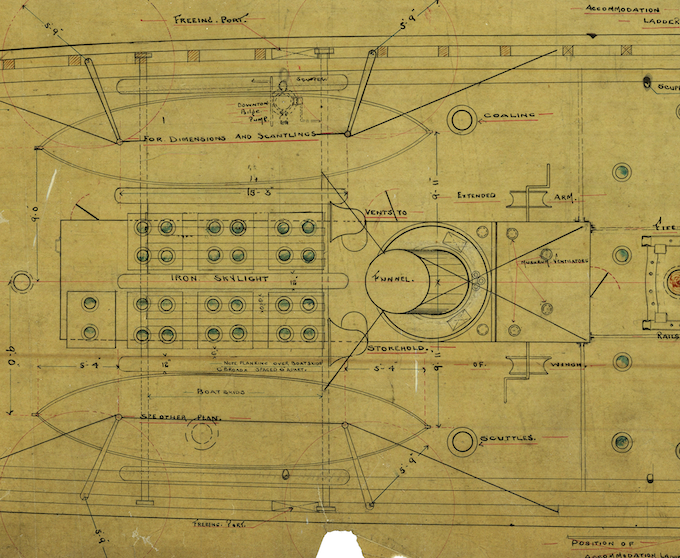
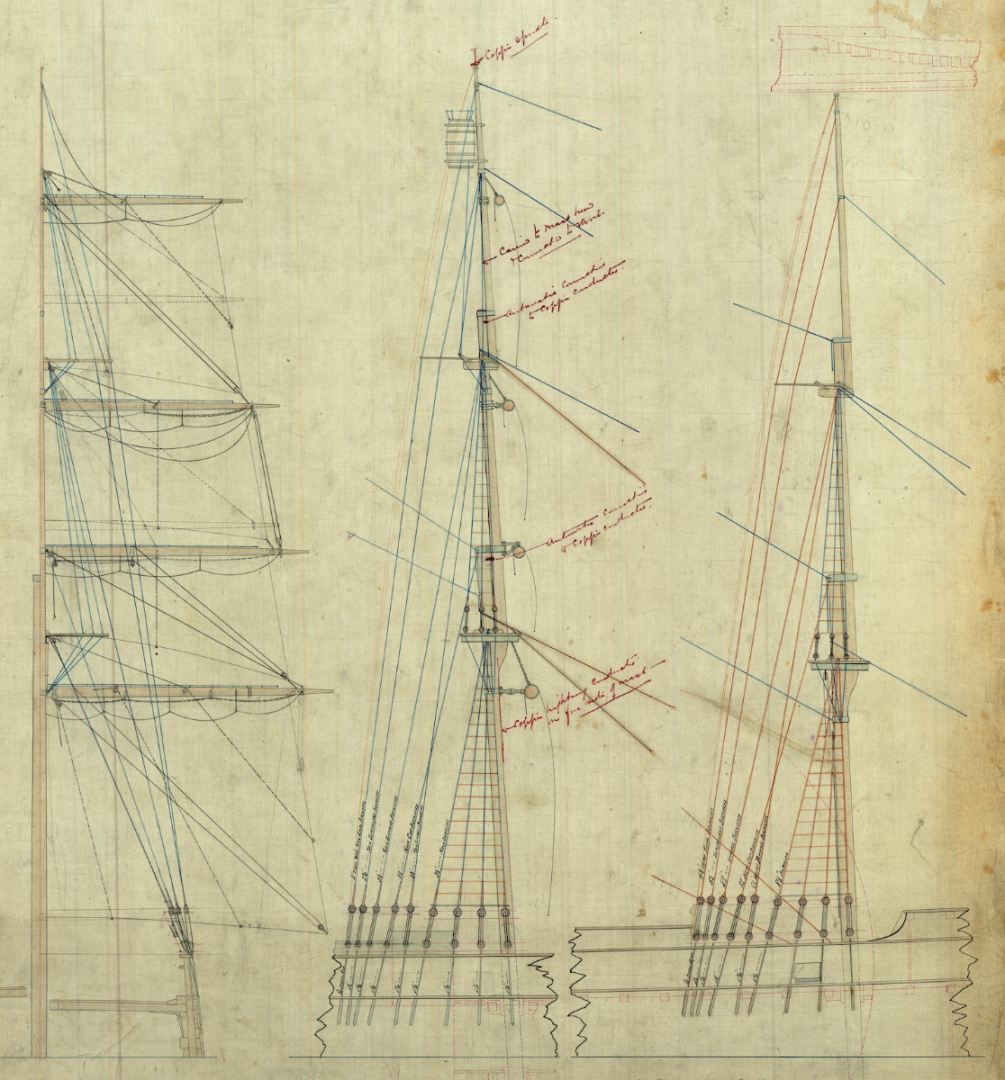
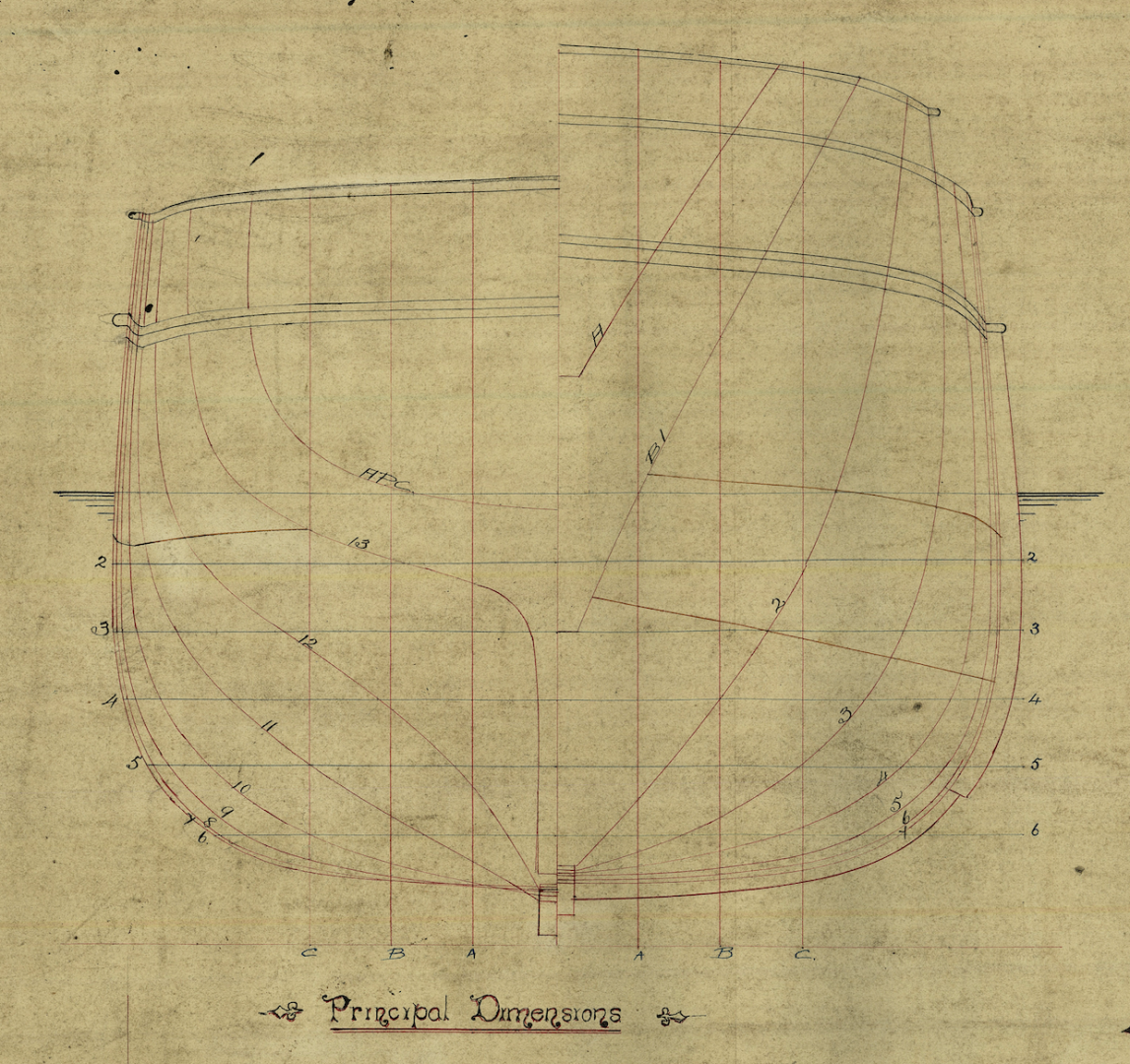
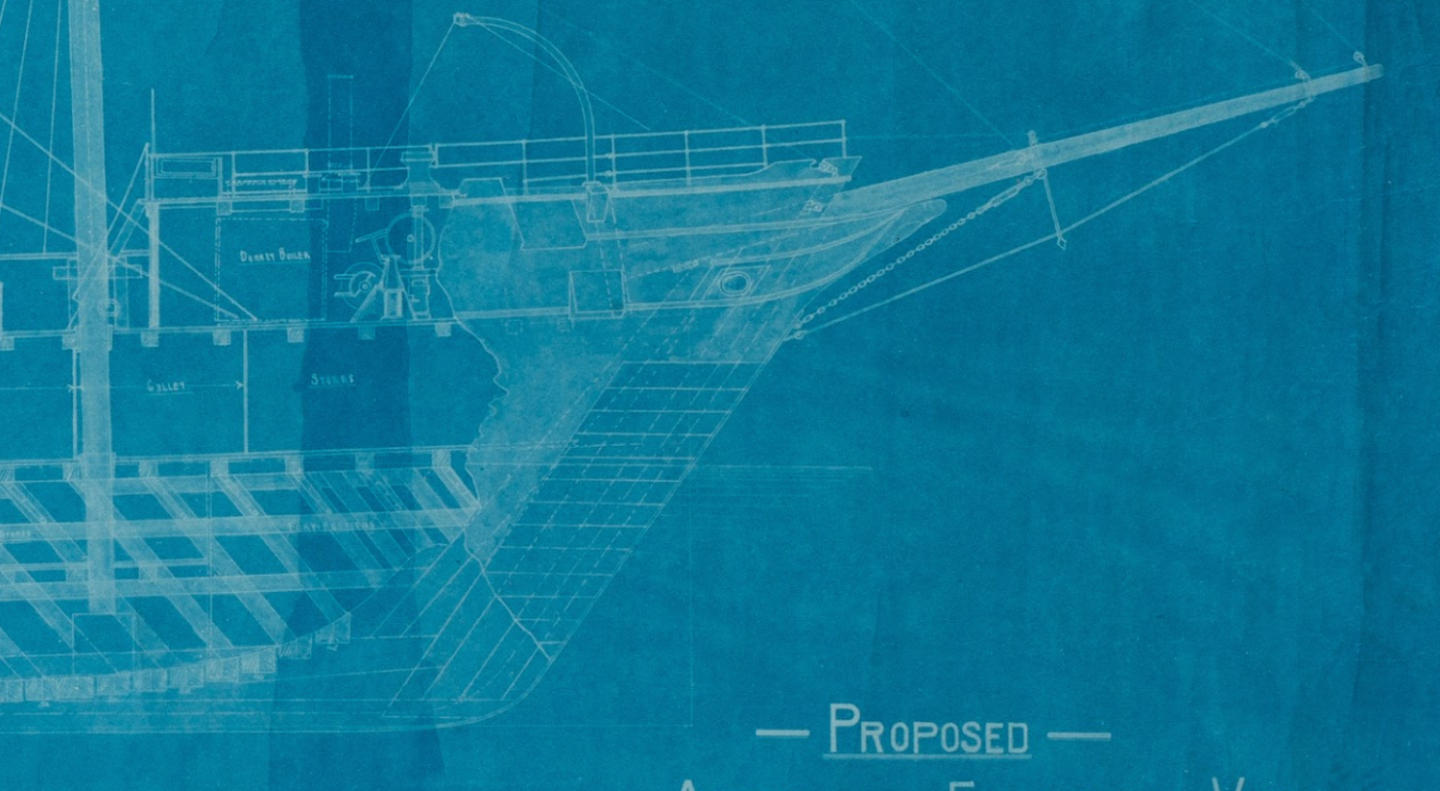
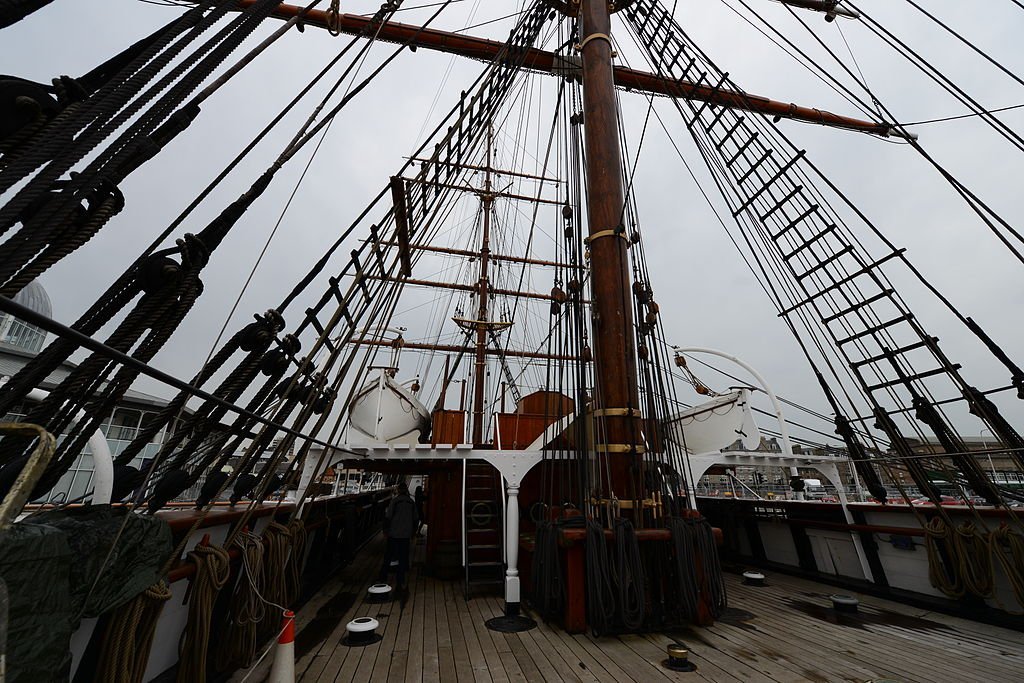

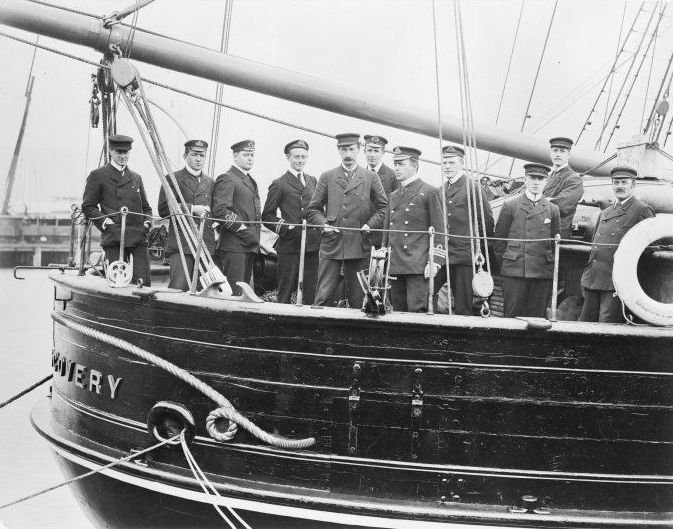
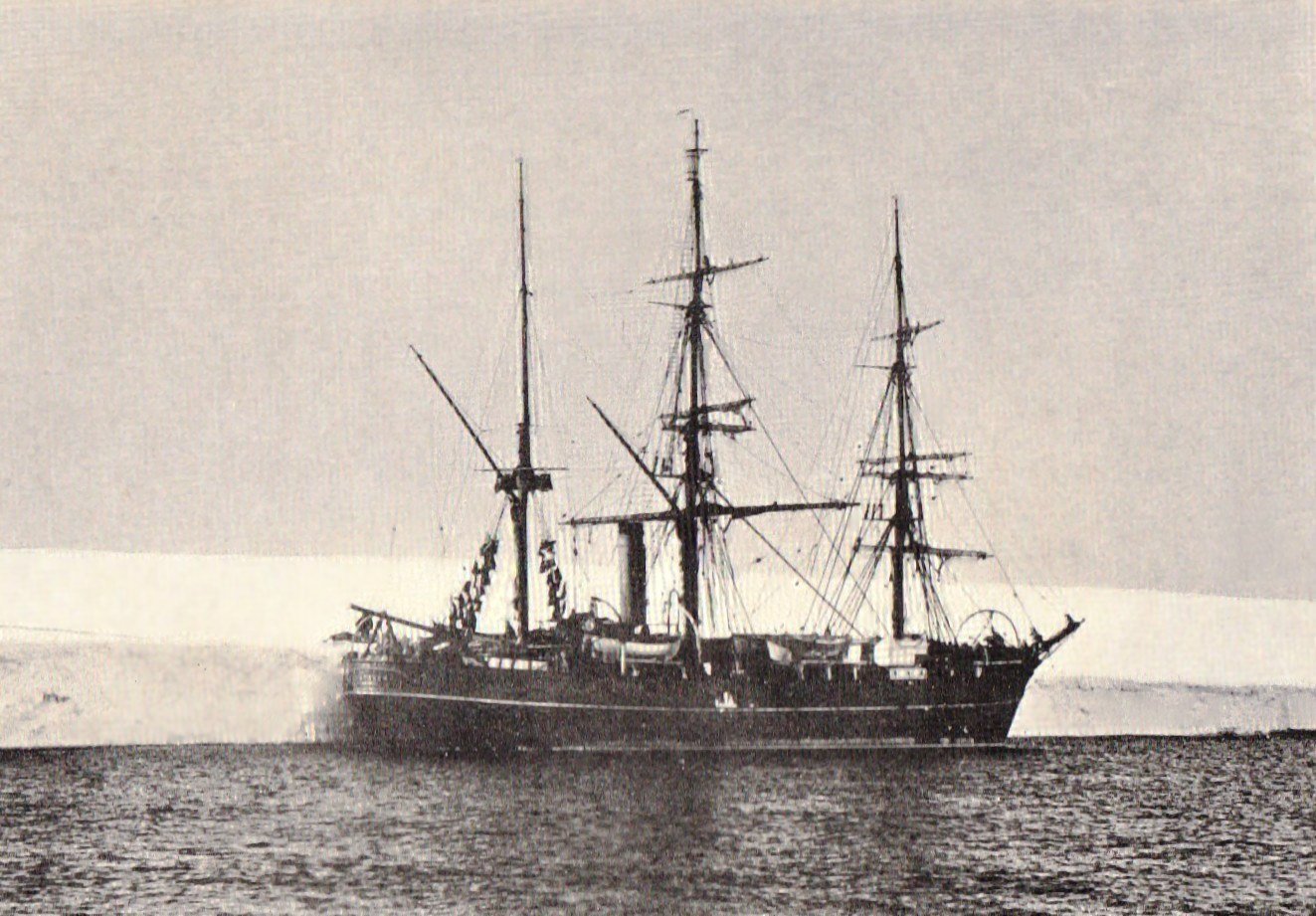
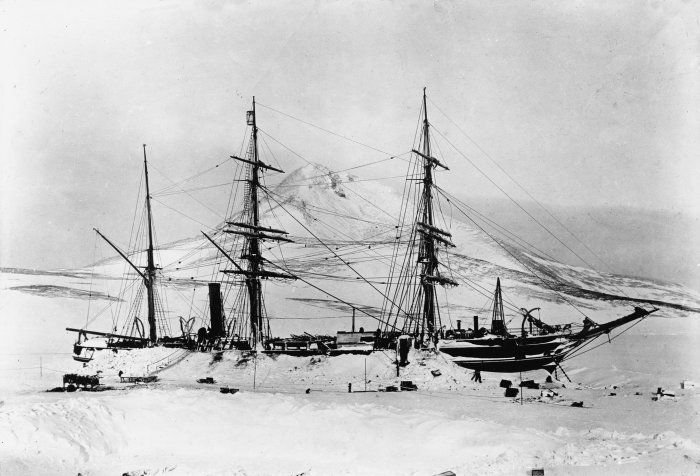
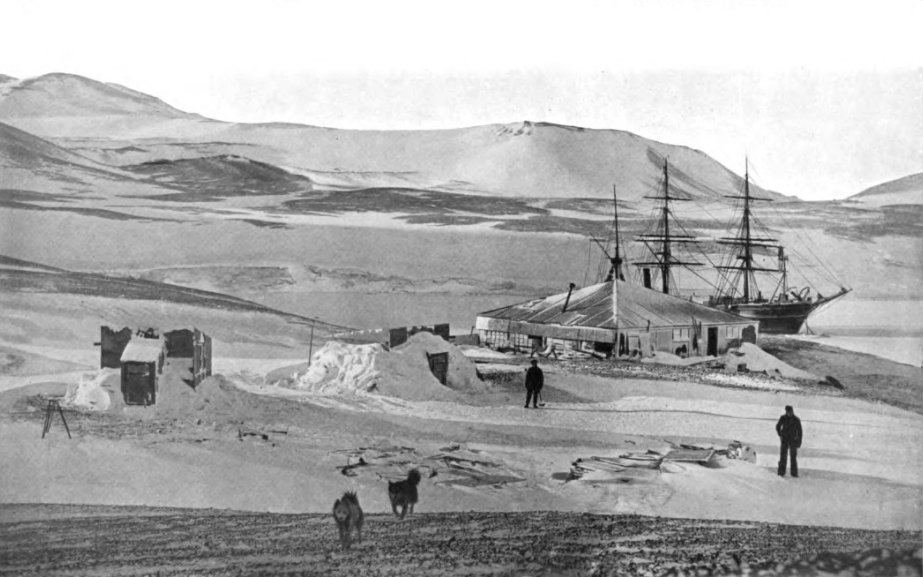
.jpeg.11e756da1340b47bbc5545f4e0cff2bd.jpeg)
